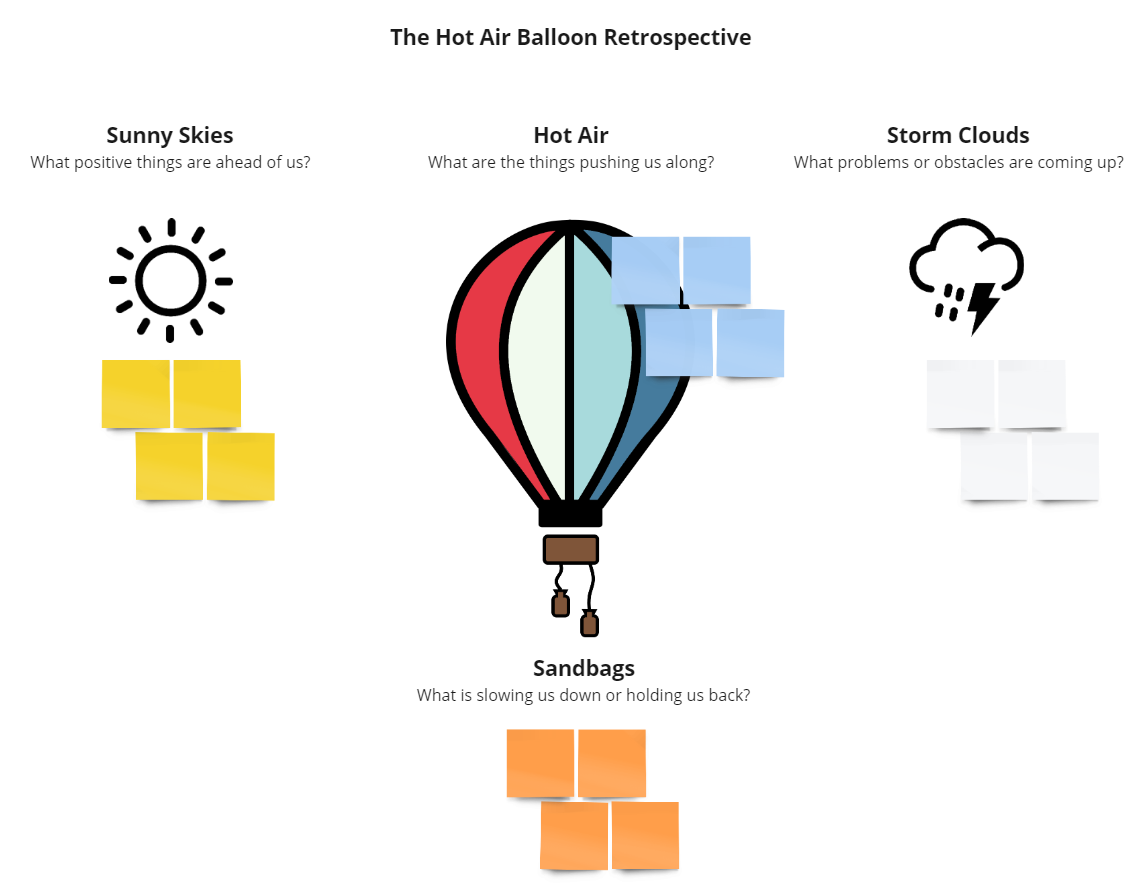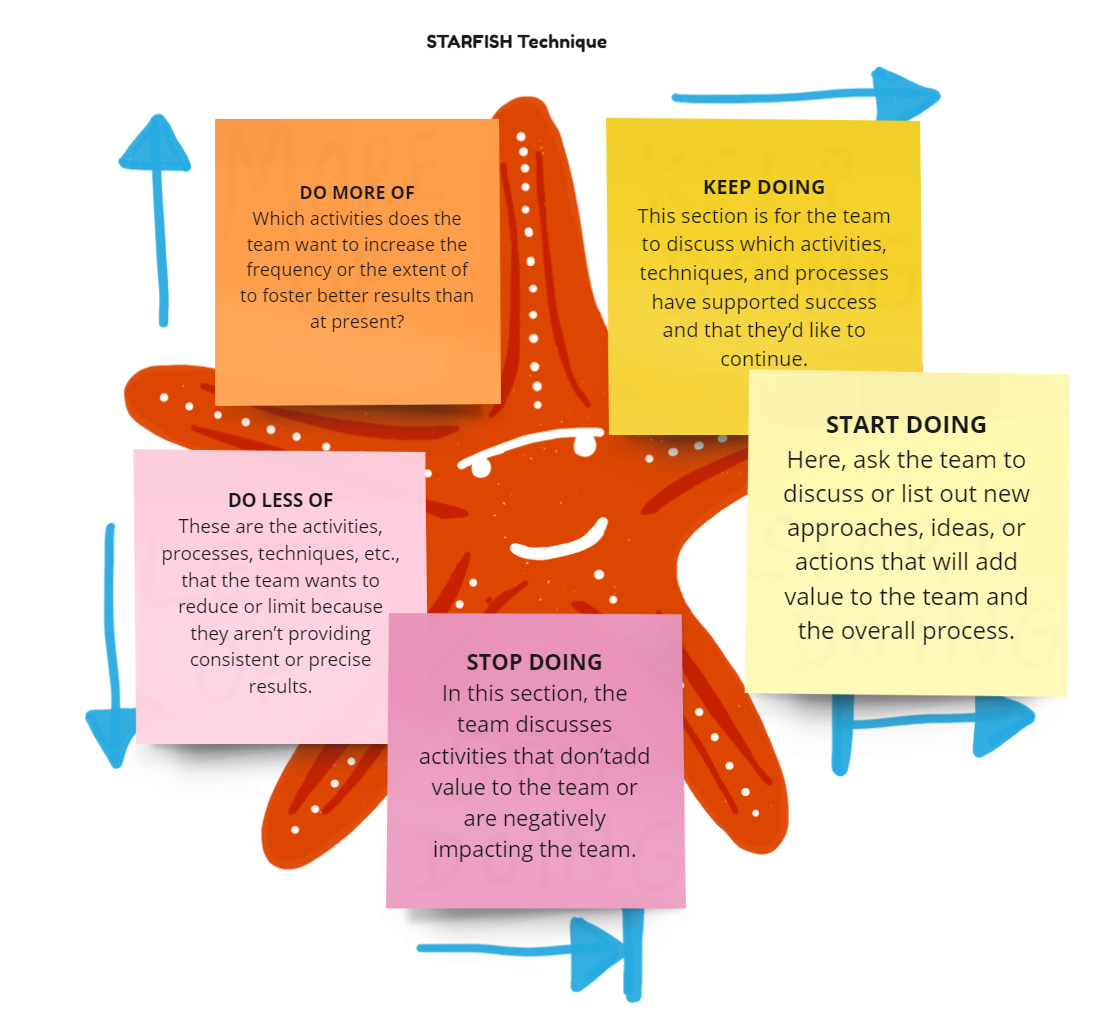Learn about purchasing for teams

Reviewed by: Bernie Maloney and Madhur Kathuria
Retrospectives are ways by which scrum teams inspect their interactions, teamwork, behaviors, processes, and tools and adapt their way of working accordingly to continuously improve themselves.
It starts with setting the stage for the scrum team to create focus, followed by gathering data from the whole team. It may be facilitated by the scrum master or any other member of the scrum team.
4 Ideas for Retrospective Formats
There are various retrospective templates that help the team to grow toward continuous learning and improvement in order to increase productivity and minimize resistance. Each serves a different purpose and might work for some teams but not for others.
Hot Air Balloon Technique
This technique is very helpful when a team finishes a financial year or completes a particular feature. It enables them to look back and reflect on their past performance and to learn from those experiences to combat the upcoming hurdles.

Past performance (looking backward): can be visualized through two components, namely, “hot air” and “sandbags”. “Hot air” illustrates the things that helped the team soar in the sky. “The sandbags”, on the other hand, are the things that derailed them or impeded their performance.
Future performance (looking forward): Use storm clouds and clear skies to visualize future performance. Storm clouds help the team to forecast potential future risks that could affect its productivity while clear skies reflect the upcoming opportunities that would bring positive experiences in the future.
Starfish Technique
This is an extended version of start, stop, and continue (which is a format that asks what should we start doing, stop doing, and continue doing?). This format provides additional insights into the data gathering.

1-2-4-All Technique (the Bubble Up Technique)
This type of retrospective is particularly helpful when the team members are hesitant to speak up or holding back. Instead of having to speak in front of everyone extemporaneously, they can write down their thoughts first.
In this technique, each teammate is given a card or sticky note to write down their thoughts on a particular retrospective topic, such as, “What isn’t working well in our communication processes?” Participants get the chance to first think individually and then in larger and larger groups of people until the whole team is brought together.
You can use online sticky note collaboration tools or physical notes for in-person retrospectives.
Once individuals have had time to think and write down their thoughts, they are randomly paired in groups of two and asked to share their cards with each other. Then, the group of two either selects one of the notes they wrote or creates a new card based on their conversation to move forward to the larger group discussion.
Then, the groups of two are formed into groups of four and the process continues. At last, all of the participants are asked to consolidate the thoughts they’ve written down and selected into a single card to be presented. While this technique works best in face-to-face mode, it can be quite effective in providing results virtually through various collaboration tools.
Sailboat Technique
This is a technique that is very versatile and can be used to provide direction to a team when they are unsure of what they want to achieve in the future.
It’s especially beneficial in teams where predictability is a challenge or in the case of teams where attrition might lead to loss of self-management. It consists of a sailboat, the island or the shore, the wind, anchors, and rocks.
- Sailboat. It illustrates the team
- The island (shore). Resulting objective of the team or the vision towards which the team is leading
- The wind (sails). Represents things that are helping the team to increase the flow
- Anchors. Factors that are causing the team to lag or to delay them to proceed further
- Rocks. The bottlenecks and the risks that may block them, causing widespread impact to the project

Sprint Retrospective Tips for Scrum Masters
Below are some of the tips that support and revitalize effective retrospectives:
- Having a round-robin technique in retrospectives ensures everyone has a chance to contribute, including those who otherwise tend to avoid participating for various reasons.
- Guide and support the team members as they discuss retrospective topics. As a scrum master, you may suggest topics you think can spur discussion for the team. But refrain from providing your decisions or pushing your viewpoints to the team so that they can come up with a solution based on collaboration.
- Avoid having a monotonous retrospective format that disengages the team members from providing inputs. A scrum master should help a team deploy creative retrospective formats in the future.
- Scrum masters should sometimes set the stage by talking about non-formal topics like what the team did last weekend or will be doing in the forthcoming weekend, a team member’s birthday celebration, etc., when the team’s morale is low, to gather the attention of all and to boost their motivation.
- For online retrospectives, scrum masters may encourage the team members to have their video turned on so they can see body language and look for cues like their level of interest, their comfort level, and whether they are struggling to adapt to new formats or not; however, respect individual preferences for cameras-off. You may have members of your team who require cameras off as part of an accommodation plan or whose focus and concentration is negatively affected by appearing on camera. Consider a policy that allows team members to choose when and if they want to turn their camera on.
- Don’t single out any individual for a specific retrospective item as that might show disrespect to them and have negative impacts on the team health. Instead, note it down and if required, have a one-to-one meeting with them to come up with a solution.
Retrospectives should be followed by adaptations by the scrum team to improve effectiveness of the meeting. These adapations should be acted upon as soon as possible and may even be added to the next sprint's backlog for the scrum team to work upon. The scrum master collaborates with the team to ensure action items are addressed as per cadence, which also boosts the morale of the scrum team and provides them a sense of conviction for their voices being heard and their inputs being put into practice.
How Developers Can Get the Most Value From a Retrospective
The developers on the scrum team play a huge part in the inspection and adaptation of the ways they work together, communicate, and collaborate.. Here are the ways they can support valuable retros for themselves and their teammates:
- Be proactive and show courage to voice the concerns that they believe would improve the processes
- Appreciate each other as a team for any nuances introduced, any different approach that helped them reduce overall efforts or for any outstanding contributions
- Prepare some points before the retrospective meeting for each of the sections so that less time is consumed thinking about the inputs by the individuals during the meeting, which could instead be used for getting insights and different perspectives from peers, and have collective buy-in by the end of retrospectives along with ways to overcome those challenges
- Individuals should support and back their peers (especially new or junior members) who are not able to articulate their thoughts properly or struggling to get the required help or resources by guiding them through a more productive path
Build alignment and momentum through better facilitation
Help your teams collaborate effectively and stay focused on outcomes that matter. The Certified Agile Facilitator (CAF) course from Scrum Alliance equips you with tools to lead engaging sessions and support teams in any environment.











